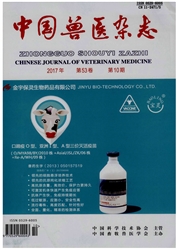

 中文摘要:
中文摘要:
为了探讨大通牦牛心肌组织对低氧环境的适应机制。选取大通牦牛作为研究对象,以平原黄牛作对照,通过显微体视学技术比较骨骼肌线粒体的平均截面积(Ax)、平均体积(V)、面数密度(NA,单位面积中线粒体数目)、体积密度(VV,单位体积骨骼肌纤维中线粒体的体积密度)。结果显示,大通牦牛心肌线粒体的平均截面积、平均体积随着年龄的增长,表现为逐渐降低的特点;而面数密度表现为随着年龄增长呈现逐渐升高的变化特点;体密度表现为随着年龄的增长逐渐增加,各年龄段差异显著(P〈0.05);大通牦牛心肌线粒体与同日龄平原黄牛比,表现为线粒体大、数量少和体密度大的特点,差异极显著(P〈0.01)。结果表明,大通牦牛心肌线粒体在出生时已表现出对高原低氧环境的良好适应性,表现为骨骼肌线粒体平均体积大、面数密度低、体密度高的特点;而在个体生长发育过程中,大通牦牛心肌线粒体平均体积逐渐变小、面数密度逐渐增大,而体积密度逐渐增大的特点,这种变化特点可以满足机体生长发育的需要和对外界环境的适应。
 英文摘要:
英文摘要:
In order to reveal the adaptation mechanism of cardiac muscle in yaks to hypoxia,Datong yak was selected,and plain cattle was as control at the same time.The average section area(Ax),average volume(V),the numerical density on area(NA)and volume density(Vv,volume density of mitochondria in unit volume of cardiac muscle fiber)of mitochondria in cardiac muscle of yak and cattle were compared by microstereolgy technology.Results showed that the average section area,average volume of mitochondria in cardiac muscle of Datong yak declined from birth to adult.The numerical density on area increased from birth to adult.The volume density of cardiac muscle mitochondria in Datong yaks increased following growth and notable differences can be ound between any two groups(P〈0.05).Volume and volume dendity of mitochondria in Datong yaks were higher notably than those in plain cattle at the same age(P〈0.01),but the number of mitochondria in Datong yaks was lower notably than that in plain cattle at same age(P〈0.01).According to the results,we can get the conclusions that cardiac muscle of Datong yak have a perfect histoheredity characteristics at birth and have a fine adaptive ability to plateau hypoxia environment,which displayed larger average volume,lower mitochondria numerical density on area,and higher mitochondria volume density.The structure change of cardiac muscle is a conseguecn to adapt their growth and the environment.Following growth, mitochondria volume density and mitochondria numerical density on area increased,but mitochondria average volume declined.
 同期刊论文项目
同期刊论文项目
 同项目期刊论文
同项目期刊论文
 期刊信息
期刊信息
